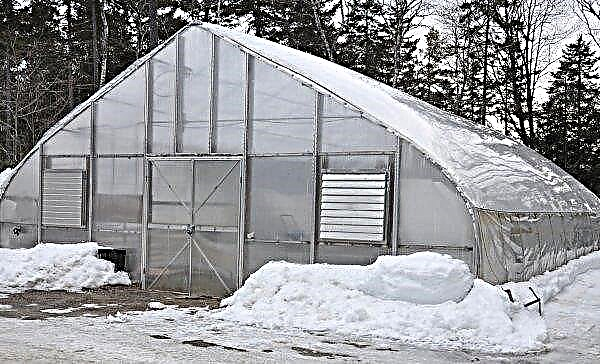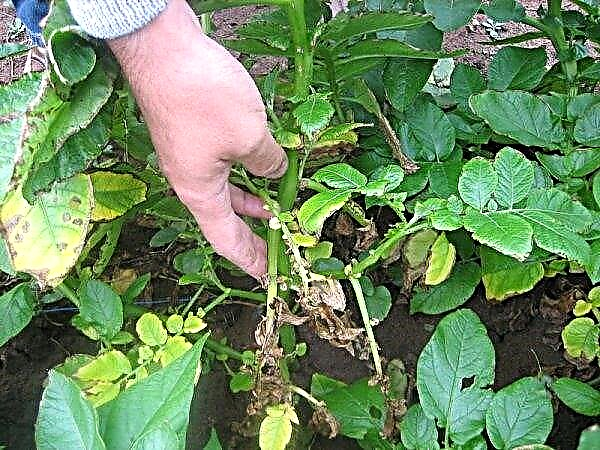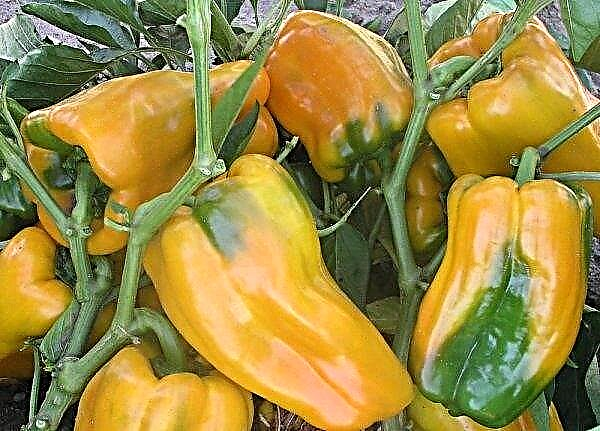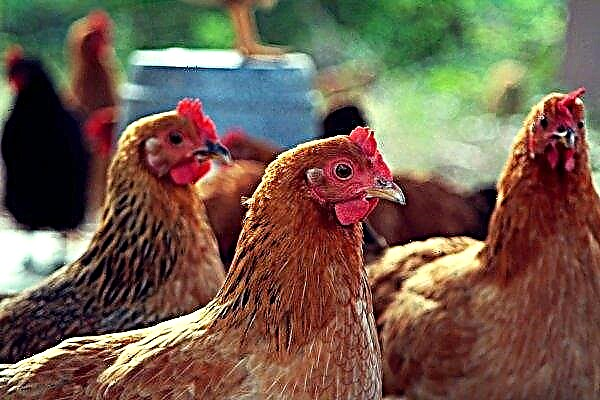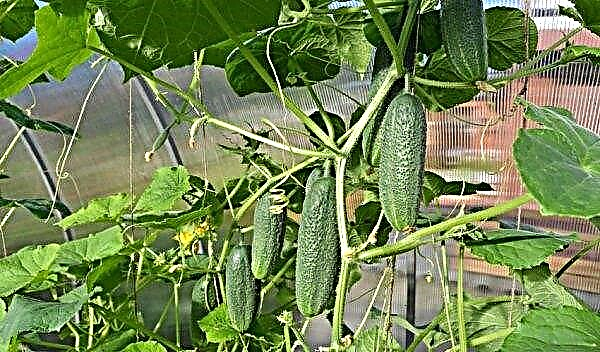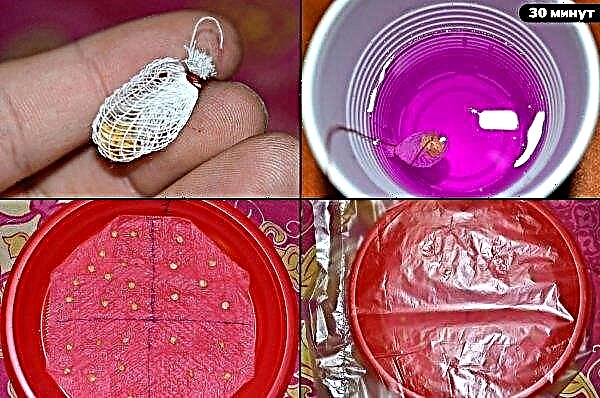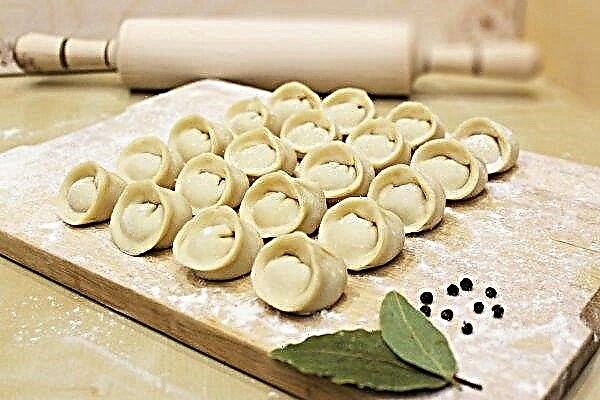With the onset of autumn, everywhere you can see beautiful and bright flowers - chrysanthemums. They can be grown not only in your garden, but also at home, in a pot. In our material we will talk about how to care for room chrysanthemum, how to transplant and propagate it at home.
Description and features of indoor chrysanthemum
Chrysanthemum is an annual or perennial plant with a branched root system. The leaves of the flower are light green, endowed with dissected edges. Inflorescences are composed of small flowers that are collected in baskets. Unlike garden views, indoor buds are smaller. Most often this is ensured by the use of drugs that slow down the growth of stems, while not affecting the buds, which gives them a decorative look.
How to choose when buying
When purchasing a flower, it is important to choose a healthy bush with strong stems and elastic buds, while the foliage should be thick. After purchase, the plant must undergo adaptation to new conditions. In order to protect the plants present in the house from diseases, a new flower is left in quarantine for several days and only then placed in others.
Did you know? Most of these flowers come from China. On these lands, chrysanthemums were cultivated in the VI century. BC e. Flowers came to us only in the middle of the XIX century.
Features of planting a flower
For full development and flowering, it is important to choose the right soil in which the chrysanthemum will grow. It can be purchased ready-made in a specialized store or prepared by yourself. It should consist of the following components (3: 1: 1: 1):
It should consist of the following components (3: 1: 1: 1):
- garden land;
- sand;
- peat;
- humus.
Soil is poured into the selected pot at 1/3 of the capacity. Set the sprout so that the roots remain on the surface. From above they are covered with soil residues. Tamping the surface is prohibited, as you may accidentally damage the roots. Humidify the earth with a spray gun.
Home Care
Consider how to care for chrysanthemum, which grows at home in a pot.
Accommodation in the house and optimal growing conditions
Chrysanthemum is a flower of short daylight. For his comfortable life, it is better to choose windows facing west or east. Too much light will cause buds to bloom quickly, and lack of it will result in no bloom. The optimal temperature should be in the summer in the range + 20 ... + 23 ° С, in the autumn - + 15 ... + 18 ° С, and in the winter - + 3 ... + 8 ° С. Only in this case, the chrysanthemum will give out the optimal number of buds and will bloom for a long time.

Good effect on the flower and high humidity (not lower than 70%). To achieve this, you can spray or wipe the leaves, and also place a container of water near the pot. In addition, during the warmer months, windows open, letting in fresh air.
Important! If you want your chrysanthemum to bloom at an unusual time, you can artificially reduce daylight hours. For this, after 10 o’clock in the morning, the plant is covered with a cap that does not allow light to pass through.
Watering and feeding
Chrysanthemum is quite whimsical in relation to moisture. She needs good watering, but without too much moisture. It is not permissible to use pallets for these colors. Soil moisture is increased only after drying of the soil from above. The best option is to water 2 times a week during growth and flowering, and 2 times a month - the rest of the time.
Flower care also includes top dressing. It is recommended to use ready-made mineral fertilizers. For this, a potassium solution or other multicomponent compositions in which nitrogen, phosphorus and potassium are present are suitable. Fertilize the flower every 10 days. Do this until the buds begin to blossom.
Pruning
A similar procedure is carried out annually at the end of flowering. Do this to increase the splendor of the bush by removing faded buds. In addition, yellowed leaves are removed, and it is recommended to pinch the tops to form lateral shoots.
Did you know? In China, chrysanthemums are used in folk medicine. With their help, they treat malaria, alcoholism, stomach diseases, and are also used to prevent heart problems.
How to transplant chrysanthemum indoor
Young flowers are transplanted annually, adults - once every 2 years. Transplantation is carried out by transshipment. To do this, take a larger pot in diameter than the previous (3 cm), and new soil. A layer of drainage is laid at the bottom of the new pot, and 1/3 of it is covered with soil. After placing the chrysanthemums together with a clod of old earth in a new pot, add soil to fill the remaining volume and carry out watering.
Video: transplanting a room chrysanthemum
Seasonal Features
To get the full bloom of violets in the autumn-winter period, it will be necessary to carry out certain manipulations during dormancy. During this period, it is important to do everything so that the maximum number of buds is formed and the number of roots increases. To do this, provide the flower with peace in a cool place without any soil moisture.
Flowering period
Most often, chrysanthemum enters flowering in the autumn-winter period. When a large number of buds is formed, some of them are removed. This will help not only speed up the blooming process, but also increase the splendor of flowers. When the chrysanthemum has already faded, many are interested in what to do next and how to ensure that the flower forms buds again next year. At the end of flowering, the plants are prepared for wintering. This should be done in the absence of new buds and when the stems are tilted to the sides.
Important! To quickly increase the volume of the root system, the size of the buds and improve the overall decorativeness, you can use a light solution of potassium humate.
Before you send the flower to rest, all the stems are cut almost to the root, and the ground is watered. For wintering, choose a cool dry place where the temperature is in the range of -3 ... + 2 ° C. The rest period on average continues until the onset of heat. At this time, the pot is returned to its old place and irrigated. Some owners do not change the location of the pot after flowering, trying to achieve repeated flowering.
How to breed
Chrysanthemums can be propagated in several ways. Let's consider each in more detail.
Seeds
In this way, only Korean varieties or hybrids are propagated. A similar method does not require much effort and special conditions. However, using this method, only annual flowers can be grown. Seeds are sown in mid-May, immediately in pots with earth. For planting, it is recommended to prepare a substrate consisting of earth, sand and humus in a ratio of 3: 1: 1. In the pot, drainage holes and expanded clay must be present.
Did you know? In the East they say: “If you want to be happy all your life, grow chrysanthemum.” These flowers are the most revered in the countries of Asia.
Soil is poured on top and seeds are sown. They need to be deepened by 1 cm. On average, sprouts appear after 2 weeks. All this time the soil should be moist, and the air temperature should be within + 18 ° С. After the appearance of several full leaves, the flowers dive into separate containers. Seedlings grow quite slowly, on this basis, flowering will come no earlier than next year.
Cuttings
This method requires additional labor costs. Cuttings should be separated from the main bush, the length of which should be at least 10 cm, while several internodes with leaflets should be present on them. Rooting is carried out in two ways: in water and soil. Before immersing in any substance, it is recommended to remove the lower leaves so that they do not begin to rot. Defused water is poured into a glass in which activated carbon is dissolved.
Cuttings are immersed in it and the container is placed in a warm and well-lit place. After the roots have reached a length of 2 cm, the cuttings are transplanted into previously prepared soil in a capacity of 200 ml. Before new leaves appear, it is recommended that they be in the greenhouse. Watering is minimal. The temperature at this time should be within + 20 ° C.
Important! Before planting stalks on the ground, on which roots have already formed, it is recommended to treat them with wood ash.
If cuttings are immediately planted after separation from the mother bush, the following manipulations are recommended:
- The lower section is treated with "Kornevin" or other means to stimulate the appearance of roots.
- Loose earth is prepared and cuttings are immersed in it to a depth of 1.5 cm.
- Watering is carried out with warm water with the addition of the same product.
- The pot is covered with a film and put in heat. So that the fungus does not appear, the greenhouse is sometimes aired and the soil is irrigated.
Video: Cutting indoor chrysanthemum
Dividing the bush
Reproduction in a similar way is carried out during the maximum growth of young shoots. On average, up to 6 young shoots can be obtained from one bush. For separation, the bush is removed from the pot. Shoots with roots are determined, with the help of a sharp knife, separation is carried out. The landing pot should be wide, but not deep. Landing is carried out in the same way as a full-fledged bush. In conclusion, the land is watered well.
Plant diseases and pests
Like many other flowers, chrysanthemum is susceptible to attack by some insects and diseases.
Consider how to deal with certain problems:
- Spider mite. A sign of the pest is the presence of a white web. To get rid of the tick, the leaves are wiped with soapy water, and then treated with Piretrum or Actellik.
- Powdery mildew. Appears as a result of severe waterlogging. Treatment is carried out by spraying with a fungicide, after which the pot is moved to a dry place.
- Gray rot. The presence is confirmed by brown spots on the surface of the leaves. In this case, the treatment with “Fundazole” is carried out, after which the pot is placed in a well-lit room.
- Septoria. If the watering is too plentiful, brown spots with a yellow border may appear on the leaves. To get rid of the problem, reduce watering and carry out treatment with Fundazol.

